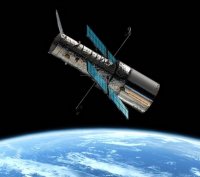Summary
The mission
 |
|
Hubble in orbit |
The Universe is gloriously transparent to visible light over journeys lasting billions of years. However, in the last few microseconds before light arrives at telescope mirrors on Earth it must travel through our turbulent atmosphere and the fine cosmic details become blurred. It is this same atmospheric turbulence that makes the stars appear to twinkle on a dark night.
Putting a telescope in space is one way of evading this problem. As well as collecting visible light from its orbit high above the atmosphere, the Hubble Space Telescope also observes the infrared and ultraviolet wavelengths that are completely filtered out by the atmosphere.
The Hubble Space Telescope, a joint ESA and NASA project, has made some of the most dramatic discoveries in the history of astronomy. From its vantage point 600 km above the Earth, Hubble can detect light with 'eyes' 5 times sharper than the best ground-based telescopes and looks deep into space where some of the most profound mysteries are still buried in the mists of time.
